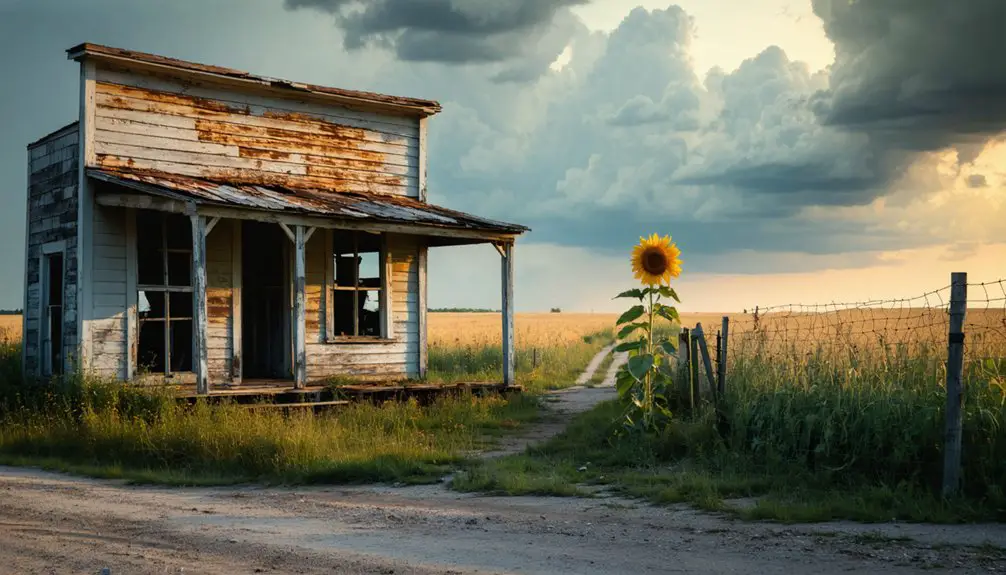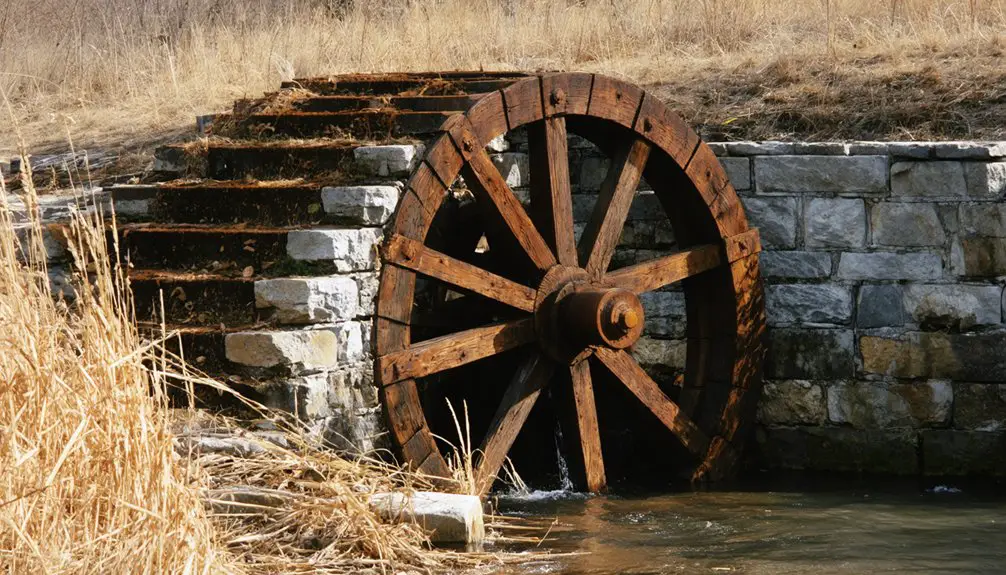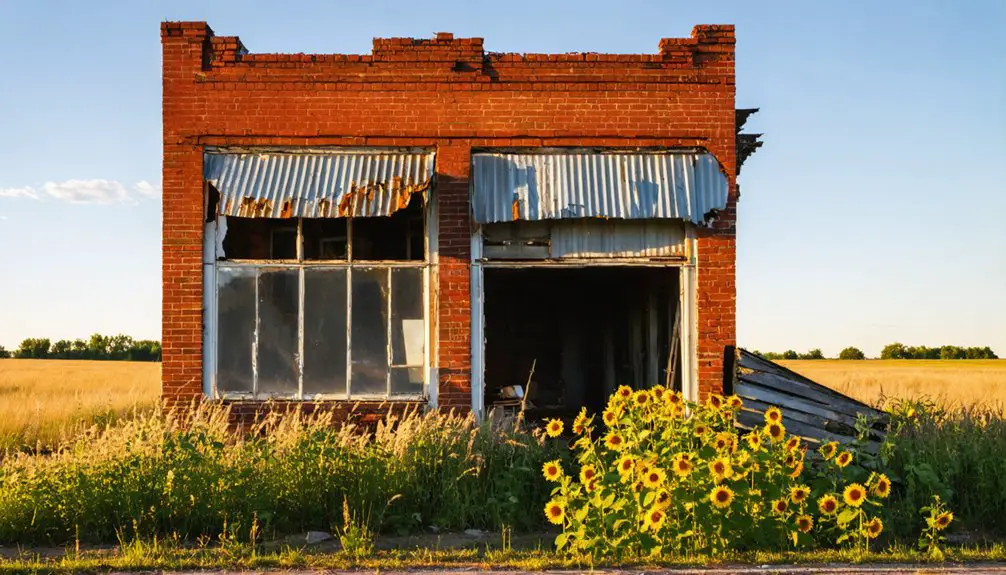You’ll find Acres, Kansas standing as a ghost town today, though it began as Manning Station in 1887 along the Santa Fe Railroad. The town flourished as an agricultural hub with a grain elevator, blacksmith shop, and general store serving immigrant farmers from England, Germany, Russia, and Sweden. After the post office closed in 1954, only the grain elevator, an old house, and abandoned school remain to tell the story of this once-bustling prairie community.
Key Takeaways
- Originally named Manning Station in 1887, the town was renamed Acres in 1889 to avoid confusion with other railroad stations.
- The town flourished as a railroad hub with a diverse immigrant population before declining due to changes in agriculture and transportation.
- Only three structures remain today: the grain elevator, an old house, and an abandoned school building.
- The post office closure in 1954 marked a significant milestone in Acres’ transformation into a ghost town.
- The grain elevator stands as the most prominent reminder of the town’s agricultural heritage and railroad-based economy.
From Manning to Acres: The Story Behind the Name
The evolution of Acres, Kansas began in 1887 as Manning Station, a name derived from a railroad conductor who operated along the newly constructed line through Clark County.
While the Manning name has noble origins tracing back to Old Norse and Anglo-Saxon Britain, meaning “brave or valiant man,” the station’s naming wasn’t connected to this ancient lineage. This etymology mirrors historical records showing the surname derived from Norse word “maningi”, representing strength and bravery. The name’s earliest documented appearances include records of Mannicus in the Domesday Book of 1086.
You’ll find the name evolution of this settlement particularly interesting, as it reflects a broader pattern of community development in the American West.
The shift from Manning Station to Acres marked a deliberate change away from railroad-centric identity toward one celebrating the area’s agricultural potential.
This change represents the community’s desire to forge its own identity, independent of the railroad company’s influence that initially brought settlers to the region.
Life in a Railroad Town: Peak Years and Development
During its peak years in the late 19th century, Acres flourished as a bustling railroad hub where daily life revolved around the rhythmic arrival and departure of trains. The railroad’s impact shaped every aspect of the town’s development, from its strategic layout to its diverse population of railroad workers, farmers, and merchants.
You’d have found a vibrant mix of immigrants from England, Germany, Russia, and Sweden working alongside American-born settlers, all drawn by the promise of opportunity.
The town’s infrastructure, though basic by today’s standards, served its purpose with wooden passenger cars and manually operated systems. Despite harsh weather conditions and economic challenges, the community thrived around essential services that supported both railroad operations and agricultural commerce, with grain storage facilities and maintenance operations forming the backbone of local industry. The town’s prosperity was partially due to federal land grants that helped stimulate railroad construction and settlement in the region. Residents faced constant threats from bandits, as evidenced by a deadly train robbery in 1883 where engineer John Hilton was killed.
The Grain Elevator Legacy: What Remains Today
Standing sentinel over the empty plains, Acres’ towering grain elevator represents both a physical tribute to the town’s agricultural heritage and one of its last remaining structures.
The elevator’s architecture, designed in the early 20th century alongside the Santa Fe Railroad, showcases the period’s innovative approach to grain storage and distribution. Early elevators utilized wooden cribbing construction with multiple square bins for grain storage. Along with the grain elevator, a single house and an old school that was relocated in 1924 are the only other structures that remain from this once-thriving community. You’ll find its weathered frame still dominating the landscape, accompanied by aging silos that once facilitated the region’s robust wheat trade.
The elevator’s agricultural impact extended beyond mere storage – it transformed Acres into a crucial hub connecting local farmers to national markets via rail transport.
While mechanization and farm consolidation eventually rendered small-town elevators obsolete, this structure endures as a reflection of Kansas’s agricultural evolution and the independent spirit of its farming communities.
Through Time: A Community’s Rise and Fall
Originally established as Manning in 1887, this rural settlement‘s identity quickly shifted when railroad officials renamed it Acres in 1889, responding to confusion over duplicate station names along the line.
You’ll find the community dynamics centered around essential services that supported local agriculture: a bustling grain elevator, blacksmith shop, lumber yard, and general store served both residents and travelers. Like many Kansas settlements that emerged after Native American relocation, the town developed on land that had previously been inhabited by indigenous peoples. The town’s fate mirrored countless others across Kansas, where mechanized farming led to declining populations in agricultural communities.
Preserving Acres’ Story: Historical Significance
As a tribute to Kansas’s railroad-era development, Acres holds significant historical value through its remaining structures and rich narrative of boom-and-bust settlement patterns.
You’ll find the town’s cultural heritage preserved in its grain elevator, abandoned school building, and the fascinating oral history behind its name change from Manning to Acres in 1889. The story captures the stark reality early settlers faced: nothing but acres of empty land stretching across the horizon. Like many Kansas towns that experienced decline, Acres suffered from lead mining depletion in nearby areas. Like the town of Columbia, Acres experienced significant challenges from destructive floods that shaped its development.
From its establishment in 1887 to its decline marked by the post office closure in 1954, Acres mirrors countless other railroad towns that rose and fell across the Midwest.
Today, you can explore these remnants of rural American life, where each weathered building tells a story of community resilience and eventual transformation into a historical touchstone.
Frequently Asked Questions
Were There Any Notable Crimes or Incidents in Acres During Its Existence?
Like a gentle prairie breeze, you’ll find Acres’ history flows peacefully – crime statistics and historical incidents reveal no documented crimes or violence in this small railroad town’s existence.
What Was the Average Property Value in Acres During the 1920S?
You won’t find exact property values for Acres in the 1920s, but regional property market trends suggest values likely dropped well below Kansas’s $22.83 per-acre average due to economic trends and abandonment.
Did Any Famous People Ever Visit or Live in Acres?
You won’t find any documented famous visitors or historical figures in available records. Primary sources and regional histories don’t show evidence of notable personalities ever living in or passing through there.
What Natural Disasters or Severe Weather Events Affected the Town?
While you’d expect tornado damage and flooding history given Kansas’ location in Tornado Alley, there’s no documented evidence of major natural disasters specifically hitting Acres, though severe storms likely affected the region.
Are There Any Documented Paranormal Experiences in Acres’ Abandoned Buildings?
You won’t find documented ghost sightings or haunted locations in Acres’ buildings. Unlike other Kansas ghost towns with paranormal claims, there aren’t any verified reports of supernatural activity in this small settlement.
References
- https://www.youtube.com/watch?v=gkfXLg-ftys
- https://dianastaresinicdeane.wordpress.com/2012/01/29/columbia-a-kansas-ghost-town-story/
- https://www.legendsofamerica.com/ks-lehunt/
- https://www.indydailyreporter.com/news/ghost-town-lehunt-history-and-local-legend
- https://legendsofkansas.com/kansas-ghost-town-list/
- https://www.archives.com/genealogy/family-history-manning.html
- https://en.wikipedia.org/wiki/Manning
- http://hausegenealogy.com/manning.html
- http://kansasghosttowns.blogspot.com/2013/02/on-rare-warm-day-in-january-i-ventured.html
- http://www.ksgenweb.org/archives/1912/m3/manning_edwin_c.html



